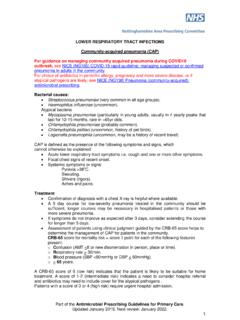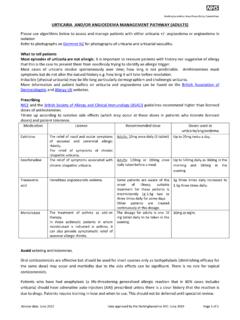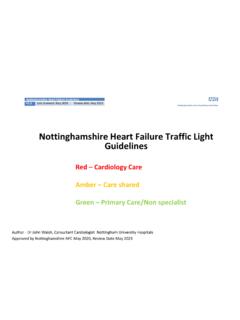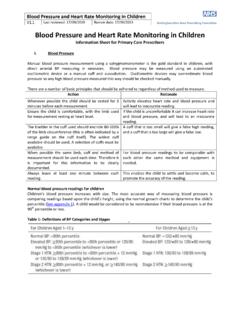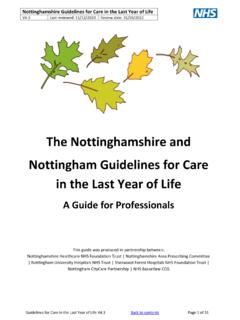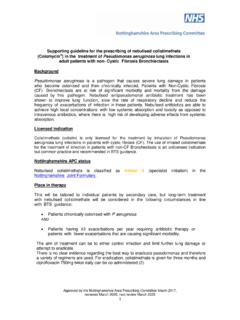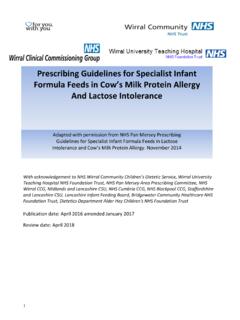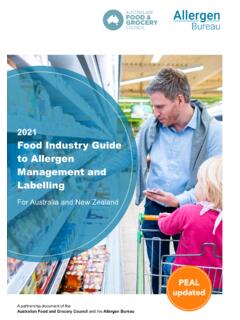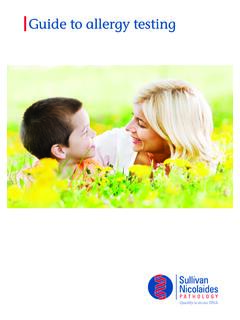Transcription of GUIDANCE ON THE DIAGNOSIS AND MANAGEMENT OF …
1 Lactose intolerance GUIDANCE Last reviewed: August 2021 Review date: August 2024 Lactose intolerance GUIDANCE 1 GUIDANCE ON THE DIAGNOSIS AND MANAGEMENT OF LACTOSE INTOLERANCE These are the lactose intolerance guidelines and it is recommended that they are used in conjunction with the Cow s milk allergy GUIDANCE . Lactose free infant formula milks are non- formulary and should not be prescribed in primary care. Key Points Breastfeeding is supported as the best form of nutrition for a good start in life for every child. Primary lactose intolerance in infants is extremely rare. It is most likely to be secondary to gastroenteritis or cow s milk allergy and should resolve if the underlying cause is treated. Mothers who breastfeed should continue to do so, do not need to switch to a lactose free infant formula, use lactase enzymes or restrict lactose in their diet.
2 Parents who bottle feed can purchase lactose free infant formula at a similar price to standard infant formula, a prescription is not necessary. Symptoms usually resolve in 2-3 days when lactose is removed from the diet and achievement of this confirms DIAGNOSIS . It is important that once children are established on a lactose free infant formula, symptoms are reviewed by parents on a regular basis and any decline or worsening is reported to the GP. Review dates should be agreed at the time of the initial consultation. Usually after an initial 2 week trial on a lactose free infant formula, then again after a further 6 weeks to discuss re-challenge. Lactose free infant formula should not be needed for longer than 8 weeks. If unable to tolerate standard infant formula after this period, alternative diagnoses should be considered infective cause, cow s milk allergy .
3 Parents should be made aware from the beginning of how long the exclusion diet is likely to be needed and a plan for re-challenge agreed from the offset. Lactose intolerance GUIDANCE Last reviewed: August 2021 Review date: August 2024 Lactose intolerance GUIDANCE 2 Background Lactose intolerance post gastroenteritis Typical symptoms of lactose intolerance include loose, watery stools, abdominal bloating and pain, increased flatus and nappy rash. Most commonly it occurs after an episode of infectious gastroenteritis (known as secondary lactose intolerance) when damage to bowel mucosa has caused a deficiency in lactase. This deficiency causes temporary lactose intolerance that usually lasts 6-8 weeks. Lactose intolerance should be suspected in all children with acute gastroenteritis who uncommonly have loose stools persisting for more than 2 weeks.
4 DIAGNOSIS can be made if the diarrhoea resolves within 2 weeks of exclusion of lactose from the diet1. Primary lactose intolerance Persistent (primary) lactose intolerance is rare in children under 3 years of age and is usually not seen before 8 years of age1, 2. It tends to be more noticeable in older children and adults, as the ability to produce lactase is lost over time. It can also be caused by a congenital lack of lactase but this is extremely uncommon. Lactose intolerance secondary to gut enteropathy If other symptoms are present such as rashes, eczema, rhinitis, vomiting, reflux and constipation or the child is not growing well, the child is more likely to have cow's milk allergy , even if some of the symptoms resolve following lactose exclusion.
5 Secondary lactose intolerance may develop in some children with gut-related symptoms associated with non-IgE mediated cow s milk protein allergy or coeliac disease, which resolve following exclusion of cow s milk protein , or gluten in the case of coeliac disease. Please refer to Cow s milk allergy GUIDANCE if the child presents with these symptoms. Treatment It is hoped that health care professionals involved in a child s health care will feel confident to give GUIDANCE on post-gastroenteritis secondary lactose intolerance without referral to secondary or specialist care. Parents/carers should be advised to give their infant a lactose free infant formula which can easily be purchased from a supermarket or pharmacy at a similar price to standard infant formula.
6 Lactose intolerance GUIDANCE Last reviewed: August 2021 Review date: August 2024 Lactose intolerance GUIDANCE 3 NB/ mothers who breastfeed should be encouraged to continue and do not need to switch to a lactose free infant formula, use lactase enzymes or restrict lactose in their diet. Secondary lactose intolerance in infants post gastroenteritis usually lasts 6-8 weeks, so parents will also need to understand how to follow a low-lactose diet. They should be given advice to guide them through this [Refer to temporary lactose intolerance patient information leaflet (PIL)], but referral to a dietitian should not be necessary, as it is a short term condition and there are suitable low lactose cow s milk based products available. In primary lactose intolerance, there tends to be a gradual loss of lactase over time, and therefore a gradual reduction in the amount tolerated of lactose containing dairy products.
7 A range of low lactose products are available to buy in supermarkets and this is usually sufficient for the majority of children (Appendix 1). As this is a condition seen in older children, lactose free infant formulas are not necessary. Re-challenging If infectious gastroenteritis was thought to be the cause of lactose intolerance, then the infant should be re-challenged with lactose after 6-8 weeks. This will mean gradually re-introducing their standard infant formula, or foods if already consuming solids [refer to Temporary lactose intolerance patient information leaflet (PIL)]. If taking solids, start with a small pot of yogurt or some cheese, before gradually introducing standard infant formula. If the re-challenging process fails, lactose intolerance is more likely to be secondary to non-IgE mediated cow s milk allergy .
8 Refer to the Cow s milk allergy GUIDANCE from hereon. References 1. Heine R et al, 2017. Lactose intolerance and gastrointestinal cow s milk allergy in infants and children common misconceptions revisited. World allergy Organization Journal 2. Bayless TM et al, 2017. Lactase non-persistence and lactose intolerance. Curr Gastroenterol Rep; 19 (5): 23 3. NHS Lactose intolerance; Last accessed Lactose intolerance GUIDANCE Last reviewed: August 2021 Review date: August 2024 Lactose intolerance GUIDANCE 4 Secondary Lactose Intolerance Advise parents/carers to purchase a lactose free infant formula and/or restrict lactose from the diet Symptoms resolve Yes No Advise to continue on restricted diet for a further 6 weeks Consider other causes of symptoms and rule out CMA Review and discuss gradual re-introduction of lactose as per lactose intolerance PIL No recurrence of symptoms Recurrence of symptoms Provide dietary advice Primary Lactose Intolerance suspected Refer to the cows milk allergy guidelines Lactose Intolerance Algorithm Review after 2 weeks Lactose intolerance GUIDANCE Last reviewed: August 2021 Review date.
9 August 2024 Lactose intolerance GUIDANCE 5 Appendix 1 Low lactose diet for primary lactose intolerance in children over 2 years of age This involves avoiding all key sources of lactose fresh, heat treated and powdered cow s milk and other mammalian milks sheep, goat and dairy products including soft and cottage cheeses, yogurt, fromage frais and ice cream. Your child should tolerate the small amounts of lactose found in foods and medicines, so you should not need to read labels. However, if foods containing milk / lactose as an ingredient seem to trigger a reaction, you will need to check labels for the presence of milk , which will be highlighted in bold in the ingredients list. More detailed dietary information can be obtained via the allergy UK website (choose lactose intolerance from the list at ).
10 Suitable low lactose foods Naturally low lactose dairy products Mature Farmhouse cheddar cheese, Parmesan, Gruyere, Emmental cheese Butter Arla Lactofree products (based on cow s milk so contain equivalent calcium): Full cream, semi-skimmed and skimmed Lactofree dairy drinks ( milk equivalent) Lactofree fruit yogurts Lactofree semi-hard and soft cheese Lactofree cream Lactofree spreadable Soya based products Wide range of soya milks available (Ensure they are fortified with calcium and choose unsweetened if possible) Soya yogurts, desserts and custard (ensure fortified with calcium) Soya cheese range of soft, hard and melting versions (do not contain calcium) Soya ice cream Other milk substitutes Wide range of other milk alternatives including those based on oat, coconut, hemp, nuts and quinoa.
